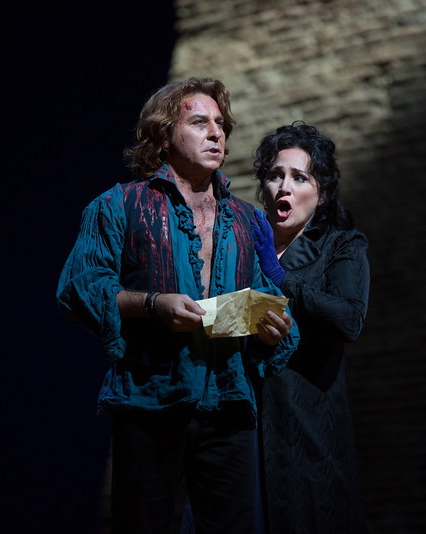Alagna bedazzles as staging bewilders in Met’s mixed “Tosc
By courtesy of Mr. Simpson.
When Luc Bondy’s production of Tosca opened in 2009, the staging suffered from direct comparison with the frilly but well-loved Zeffirelli production that it replaced.
Occasionally a new cast and a different stage director willing to play around a bit can help to tie up some loose ends and salvage a messy production.
This is especially true when the sets themselves are fairly tame, as is the case with the inoffensive scenic design by Richard Peduzzi.
The production returned to the Met for its third go-around, with a promising lead cast of tenor
Roberto Alagna and soprano Patricia Racette but apparently no one took a fresh look at the stage direction.
Paula Williams left much of the original blocking intact, including all of the biggest head-scratchers.
In the first act, the congregation of Sant’Andrea della Valle is shocked — while the audience is mostly just weirded out — when Scarpia awkwardly feels up an effigy of the Virgin.
In the second act, Tosca contemplates throwing herself out the window of Scarpia’s apartment, but can’t work up the nerve.
When she finally does decide to go for it in act three, she runs back and forth along the parapets of the Castel Sant’Angelo, but can’t seem to find the way down.
To paraphrase Orson Welles, there is too much directing going on around here.
Cavaradossi is spared most of the directorial goofiness, but Alagna can be frustrating as an actor in his own right, often falling into wipe-the-brow, clutch-the-chest gestures when singing alone.
He delivered a beautiful, rich-toned “Recondita armonia” albeit while clutching a locket about waist-high and staring to the back of the house.
Even when he appears stiff, however, he can carry a performance with his vocal power, as he showed in a soaring, high-octane “E lucevan le stelle,” earning a generous cheer for his intense and sensitively phrased singing.
His voice has tremendous weight and when applied to lyrical arias, the effect is similar to nestling into a down mattress.
The French-Sicilian tenor came to life when playing off of Racette, especially in the first act, as Tosca’s flashes of jealousy gave way to playful teasing.
Racette’s singing was mostly polished, but lacked fire.
In “Vissi d’arte” she had a few soaring moments but her technique failed her.
Her vibrato was spectacularly wobbly at the top and the last note was noticeably flat.
The baritone George Gagnidze’s voice is less than thunderous, and the direction tended strand him upstage, which at times made him difficult to hear.
He was nonetheless an imposing, menacing Scarpia.
He has a fabulously round, full-bodied tone that lets him sing his more lyrical strains rather than just grating through them for dramatic effect.
In the first act he showed subtle flashes of genuine concern over Tosca’s distress, lending a dash of humanity to a role that is often flatter than drywall.
This sympathetic tack was unfortunately abandoned when the curtain came up on the three prostitutes lounging in his grimy lair, reducing him to a back-alley creep.
Riccardo Frizza got off to a fine start in the pit, leading a first act that was tightly focused and not as swoopy as we’re used to hearing with Puccini.
Thereafter, he seemed to shy away from the score—the torture scene in the second act suffered from an acute lack of intensity, and his conducting in the third act seemed disinterested.
It did not help that the only action onstage at this point was a half-hearted game of chess between Cavaradossi and his jailer (a booming Ryan Speedo Green, in his company debut).
The veteran John Del Carlo was a flummoxed but endearing Sacristan, with plenty of cushion in his voice.
Donovan Singletary brought a gristly sound to his noble portrayal of the fugitive Angelotti, and James Courtney made a sneering Sciarrone.
(c) Mr. Simpson.






No comments:
Post a Comment